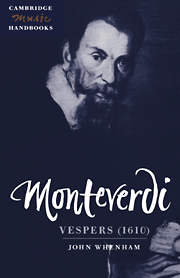Book contents
- Frontmatter
- Contents
- Acknowledgements
- List of abbreviations
- 1 Introduction
- 2 The 1610 settings and the liturgy of Vespers
- 3 The 1610 print and Monteverdi's career
- 4 ‘Suited to the chapels or chambers of princes’
- 5 ‘And all on a cantus firmus’
- 6 Issues of performance
- Appendices
- Notes
- Select bibliography
- Discography
- Index
5 - ‘And all on a cantus firmus’
Published online by Cambridge University Press: 12 January 2010
- Frontmatter
- Contents
- Acknowledgements
- List of abbreviations
- 1 Introduction
- 2 The 1610 settings and the liturgy of Vespers
- 3 The 1610 print and Monteverdi's career
- 4 ‘Suited to the chapels or chambers of princes’
- 5 ‘And all on a cantus firmus’
- 6 Issues of performance
- Appendices
- Notes
- Select bibliography
- Discography
- Index
Summary
Whether prompted by Mantuan precedent or an eye to papal reception, Monteverdi's decision to set the strictly liturgical texts of the Vespers service on appropriate plainsong cantus firmi was a strategy that had several advantages. It enabled him to present himself as a composer competent to work with the basic musical language of the Church and to demonstrate the range of invention that he could bring to cantus firmus based pieces. It allowed him to show that such settings, though conservative at base, could incorporate thoroughly up-to-date elements of musical style. And, perhaps not least, it helped him solve a problem inherent in setting the psalms and Magnificat – that of achieving musical coherence when working with texts that were sometimes long and unwieldy and certainly not designed for setting by an early seventeenth-century madrigalist.
The texts that Monteverdi set and the plainsongs he used are shown in Appendix 2 and, in the case of the psalms and Magnificat settings, the parts bearing the psalm tones are identified. Monteverdi uses not only the pitches of the plainsongs as the basis of his settings, but also their verse and/or phrase structures, so that his settings appear, as I suggested earlier, rather like falsobordone settings projected on to a larger canvas. For this reason the logic of the settings is most easily followed if the texts are laid out with the verse divisions found in the original liturgical books, as shown in Appendix 2 (in this scheme the doxology – the ‘Gloria Patri …’ – sung at the end of each psalm and the Magnificat forms the last two verses of each setting and has been numbered accordingly).
Information
- Type
- Chapter
- Information
- Monteverdi: Vespers (1610) , pp. 60 - 81Publisher: Cambridge University PressPrint publication year: 1997
